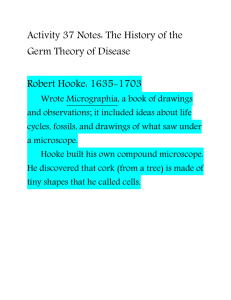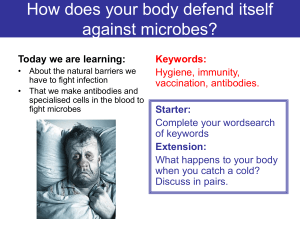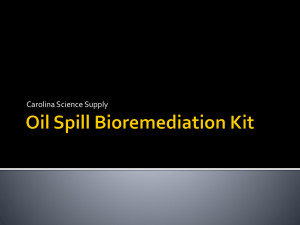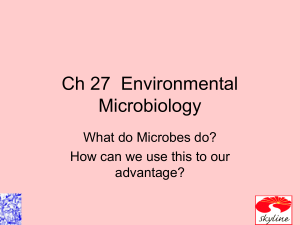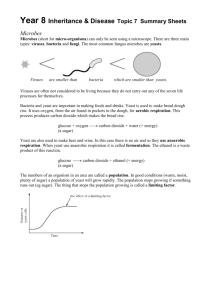Hand Hygiene - e-Bug
advertisement
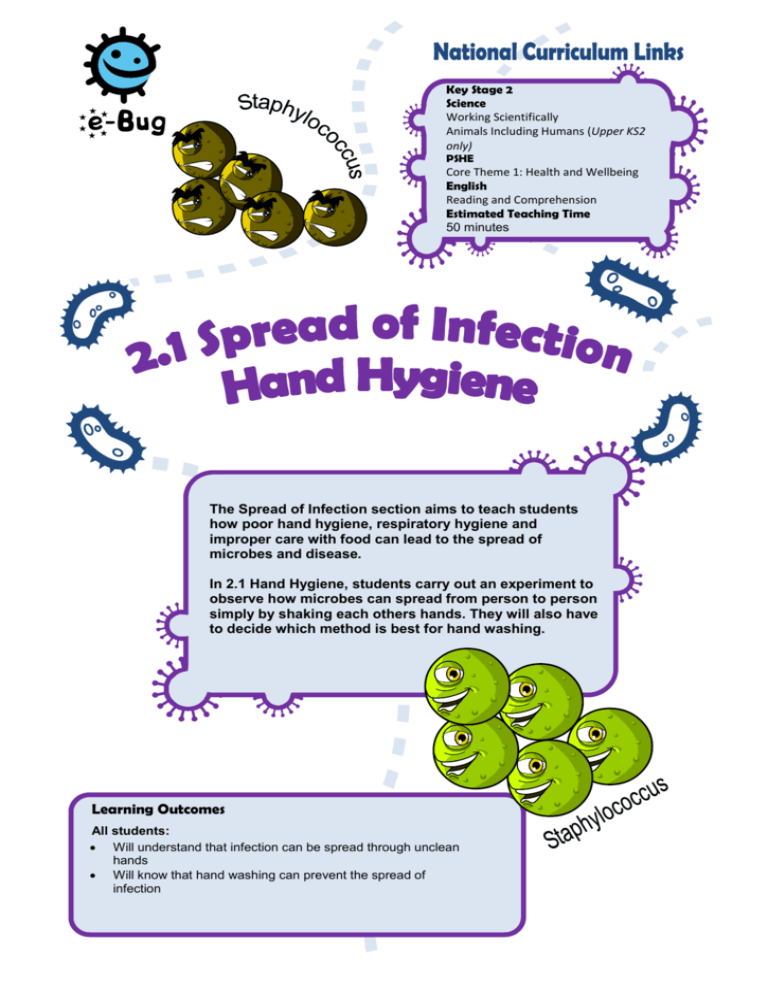
Key Stage 2 Science Working Scientifically Animals Including Humans (Upper KS2 only) PSHE Core Theme 1: Health and Wellbeing English Reading and Comprehension Estimated Teaching Time 50 minutes The Spread of Infection section aims to teach students how poor hand hygiene, respiratory hygiene and improper care with food can lead to the spread of microbes and disease. In 2.1 Hand Hygiene, students carry out an experiment to observe how microbes can spread from person to person simply by shaking each others hands. They will also have to decide which method is best for hand washing. Learning Outcomes All students: Will understand that infection can be spread through unclean hands Will know that hand washing can prevent the spread of infection 2.1 Spread of Infection Hand Hygiene Key Words Antibacterial soap Contagious Hygiene Infection Infectious Transfer Materials Required Per student Copy of SW 1 Copy of SW 2 Per group Copy of SH 1 Basin Hand soap Paper towels Cold or warm water Oil based Glo Gel and UV lamp or cooking oil and cinnamon Health and Safety If using cinnamon as an alternative to Glo Gel, take care of children with sensitive skin conditions Ensure that the lead students have no soap allergies or sensitive skin conditions Background Information Schools are a haven of harmful microbes that spread rapidly from child to child via touch. Washing your hands is one of the best ways to STOP harmful microbes from spreading and preventing us from getting sick. Our hands naturally secrete oil which helps to keep our skin moist and stops it getting too dry. This oil, however, is a perfect place for microbes to grow and multiply and helps microbes ‘stick’ to our skin. Our hands are naturally covered by our useful bacteria – usually useful Staphylococcus. Washing our hands regularly helps to remove the other microbes we collect from our surroundings (e.g. home, school, garden, animals, pets, food). Some of these microbes can make us ill if eaten or breathed in. Washing hands in water alone even in cold water will eliminate visible dirt and grime; however, soap is required to break up the oil on the surface of the hands which traps microbes. Hands should be washed: - before, during and after preparing food - After using the bathroom - After exposure to animals or animal waste - After coughing, sneezing or blowing your nose - If you’re ill or have been around ill people Advance Preparation 1. Copy SW 1 and SW 2 for each student. 2. Copy SH 1 for each group. 3. Arrange four desks side by side, each desk should contain either: a. A sign reading ‘No hand washing’ b. A basin of cold water, paper towels and a sign reading ‘Wash in Cold Water’ c. A basin of warm water, paper towels and a sign reading ‘Wash in Warm Water’ Available Web Resources A demonstration of this activity A poster showing the recommended method of hand washing d. A basin of warm water, hand soap, paper towels and a sign reading ‘Wash in Warm Water and Hand Soap’ Alternative Suggestion If Glo Gel and a UV lamp are unavailable, ask the student at the front to cover their hands in cooking oil or an equivalent non harmful oil and sprinkle well or cover with cinnamon or glitter. 2.1 Spread of Infection Hand Hygiene Introduction 1. Begin the lesson by asking students how many have washed their hands today? Ask them why they washed their hands (to wash away any microbes that might be on their hands) and what would happen if they didn’t wash away the microbes (they might get ill as they will eat or breathe in harmful microbes from their dirty hands). 2. Tell the students that we use our hands all the time, and that they pick up millions of microbes every day and that although many of these are harmless some could be harmful. Explain to the students that we spread our microbes to our friends and others through touch, and this is why we wash our hands. 3. Explain to students that they are going to do an activity to show them how best to wash their hands to remove any of the harmful microbes which may be on their hands. Main Activity 1. Divide the class up into four equal separate groups 2. Ask each student to stand in a row one behind the other and designate groups as follows a. No hand washing b. Wash hands in cold water c. Wash hand in warm water d. Wash hands in warm water with soap 3. Blindfold the lead person in each group and cover their hands in Glo Gel. The blindfold ensures that they don’t wash their hands any better than normal. Ask the lead person to wash their hands according to the group they are in. 4. Once completed, they should take off their blindfold, turn around and shake hands with the person behind them. It is important that they shake hands firmly and well. The second person should then shake hands with the third person and so on until everyone in the group has shaken hands with the person in front of them. 5. When the task is complete, turn down the lights and shine the UV lamp over everyone’s hands, starting with group A. 6. Ask students to fill out their answer sheets (SW 1 and SW 2). Plenary 1. Discuss the results with the students. What results did they find the most surprising? Explain that the soap takes away the oil in the skin that the microbes use to stick to and hide in. 2. Discuss where the microbes on their hand may have come from. Emphasise to students here that not all the microbes on their hands are harmful; there may also be useful microbes there too! 3. Emphasise to students that we also need to wash hands properly. Highlight that bacteria like to hide in between fingers and under the nails! It is important to know both WHEN and HOW to wash our hands properly to prevent spreading microbes and potentially infection. It is not always easy to wash your hands in school; a solution may be to sneeze on your sleeve. A Bit Dirty Dirty Very Dirty What is the best way of washing hands to get rid of microbes? Clean After the activity, write your results in the box provided using the guide below and see how far the microbes have spread! After washing (or not washing) and shaking hands Student 1 Student 2 Student 3 Student 4 Student 5 No wash (control) Cold Water Warm Water Warm Water and Soap 1. On the next page draw where you saw microbes after hand washing and shaking, for your group only. 2. The method of hand washing (not control) that removed most microbes from the lead person was: Cold Water Warm Water Warm Water and Soap 3. The method of hand washing (not control) that removed fewest microbes from the lead person was: Cold Water Warm Water Warm Water and Soap 4. The method of hand washing which spread the most microbes along the line was: Cold Water Warm Water Warm Water and Soap 5. The method of hand washing which spread the fewest microbes along the line was? Cold Water Warm Water Warm Water and Soap 6. Draw a graph of how far the microbes spread for all four groups (including control). 1. What is the best way of getting rid of microbes from our hands? _______________________________________________________ 2. What difference does using soap make? _______________________________________________________ 3. When should we wash our hands? _________________________________________________________ ________________________________ Fascinating Fact 90% of germs on the hand are found under the nails! On the hands below, draw where you saw microbes after washing and shaking hands:



